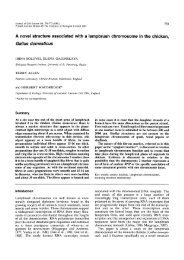Sutton Common Updated project design - University of Exeter
Sutton Common Updated project design - University of Exeter
Sutton Common Updated project design - University of Exeter
You also want an ePaper? Increase the reach of your titles
YUMPU automatically turns print PDFs into web optimized ePapers that Google loves.
side, with no portable artefacts present, but nevertheless is unrivalled for its period. The<br />
construction techniques used (with flat-bottomed posts set into very tight post pits) may not<br />
be typical for Britain (but better known from the Low Countries, where people were similarly<br />
forced to adapt to building in relative s<strong>of</strong>t sediments), but its detailed study is <strong>of</strong> national<br />
importance. The study <strong>of</strong> the archaeological wood, combined with dendrochronological studies,<br />
may also provide unrivalled insight into the woodland management <strong>of</strong> the Iron Age.<br />
The table above links the aims and objectives (A to J) described above with the methods and<br />
groups selected for analysis described below.<br />
3.2 Publication<br />
In a large number <strong>of</strong> aspects, the excavations at <strong>Sutton</strong> <strong>Common</strong> will provide information <strong>of</strong><br />
national importance: in its ability to determine with a great confidence the morphology, spatial<br />
patterning and function <strong>of</strong> this large enclosed site; the scale <strong>of</strong> excavations <strong>of</strong> the interior <strong>of</strong><br />
the site; the ability to date the phases <strong>of</strong> activity to much higher precision than has been<br />
achieved previously; a clear understanding <strong>of</strong> the interaction with the environment; the<br />
secondary deposition <strong>of</strong> cremations utilising an ‘ancient’ monument; an example <strong>of</strong> integrated<br />
study <strong>of</strong> ‘structural deposition’; a unique archaeological wood assemblage. A monograph is<br />
the only form <strong>of</strong> publication that would do credit to the importance <strong>of</strong> the site. The most<br />
appropriate publishers for this research report are English Heritage and the Council for British<br />
Archaeology. An outline <strong>of</strong> the chapters is presented below.<br />
The monograph has been <strong>design</strong>ed to take account <strong>of</strong> recent concern that the orthodox<br />
monographs, where specialists reports are presented separately rather than integrated in the<br />
text, and where ‘data’ have been separated from interpretation. This concern is both generic<br />
(Jones et al. 2003) and specific to the Iron Age <strong>of</strong> Britain (Haselgrove et al. 2001: 10). The<br />
proposed monograph will include integrated and contextualised discussions <strong>of</strong> assemblages<br />
and less compartmentalisation into specialist categories.<br />
In order to preserve standards <strong>of</strong> detailed reporting, it is proposed that a full digital resource<br />
will be prepared and submitted to the Archaeological Data Service in York. This will allow<br />
detailed scrutiny <strong>of</strong> the primary record without adding numerous pages <strong>of</strong> text and tables to<br />
the monograph. As the use <strong>of</strong> GIS forms a central component <strong>of</strong> the excavations at <strong>Sutton</strong><br />
<strong>Common</strong> and the post-excavation <strong>project</strong> (see below: 4.1), this will be achieved at limited<br />
cost.<br />
Furthermore, in a few occasions (esp. woodworking technology and palynology), the relevant<br />
specialists are asked to submit papers to specialist journals – full discussion <strong>of</strong> these aspects<br />
<strong>of</strong> the work would benefit dissemination to a specialist audience, rather than inclusion in the<br />
research monograph (see further details below).<br />
Pr<strong>of</strong>essor John Collis (Sheffield), an internationally recognised expert on the Iron Age, has<br />
been invited to act as third editor <strong>of</strong> the research monograph. His specific role is to place the<br />
information presented within the context <strong>of</strong> English/British and European Iron Age research,<br />
by alerting authors to relevant (published and unpublished) parallels from outside the wetland<br />
contexts, and to assure that information from the <strong>Sutton</strong> <strong>Common</strong> site relevant to current<br />
debates in Iron Age archaeology are suitably dealt with.<br />
The provisional title <strong>of</strong> the monograph is <strong>Sutton</strong> <strong>Common</strong>; the excavation <strong>of</strong> an Iron Age<br />
marsh-fort and cemetery, and will be edited by Robert Van de Noort, Henry P. Chapman and<br />
John R. Collis<br />
24
















